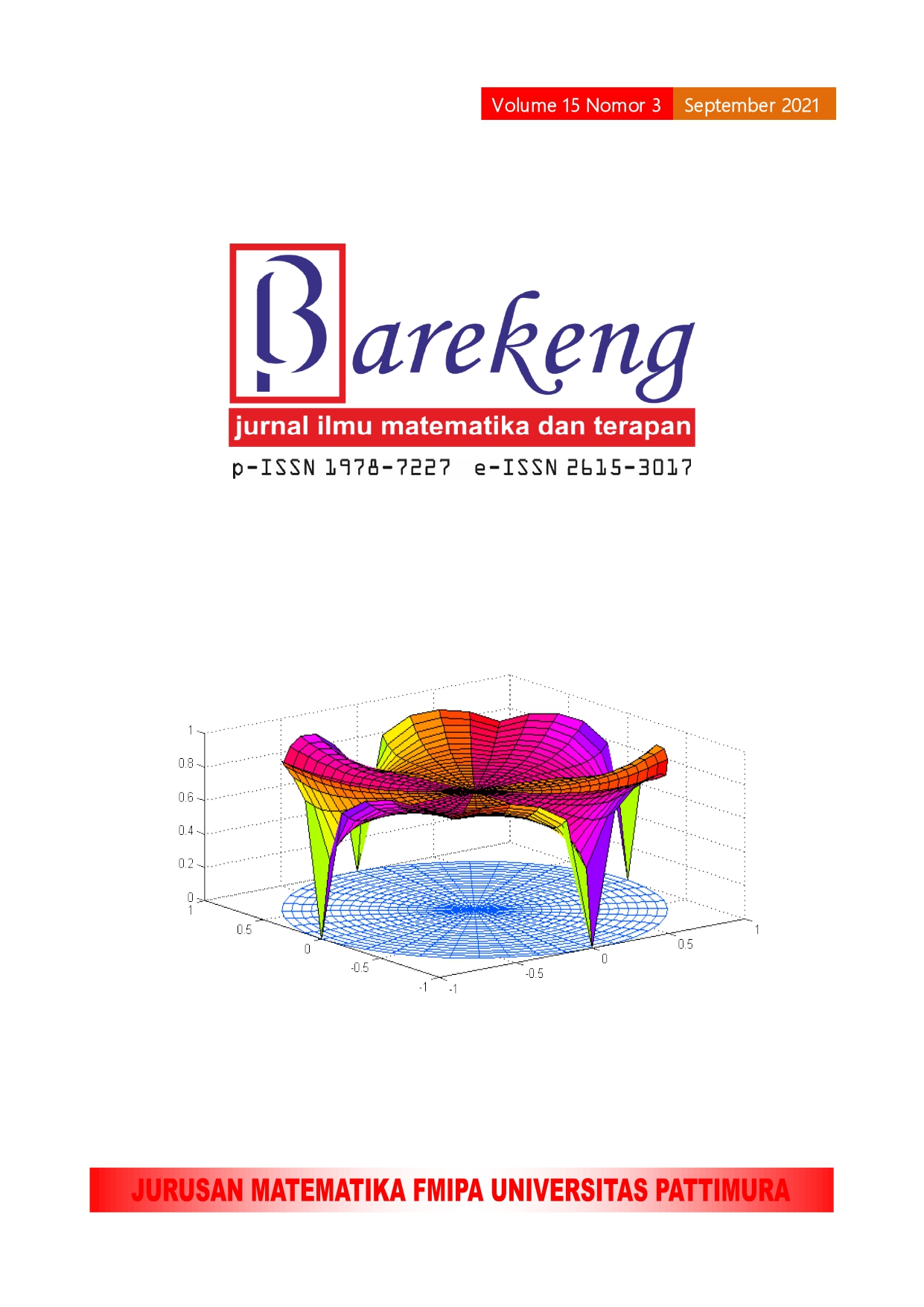KLASIFIKASI DATA PERKAWINAN ANAK DI MALUKU UTARA DENGAN METODE KERNEL REGRESSION DAN SUPPORT VECTOR MACHINE
Abstract
Salah satu tujuan Sustainable Development Goals (SDGs) yang ingin dicapai pada 2030 adalah menghapus semua praktek perkawinan anak. Di Maluku Utara, kasus perkawinan anak pada perempuan masih cukup tinggi sesuai dengan laporan Badan Pusat Statistik (BPS) yaitu sebesar 14,36 persen pada 2019, melebihi angka nasional yaitu 10,82 persen. Sehingga, informasi mengenai determinan perkawinan anak diperlukan Pemerintah untuk melaksanakan program yang bertujuan untuk menekan kasus. Untuk itu, metode klasifikasi Kernel Regression dan Support Vector Machine (SVM) dapat digunakanan untuk mengetahui determinannya. Hasil penelitian menunjukkan bahwa metode SVM memberikan ketepatan klasifikasi yang lebih tinggi yaitu 99,17 persen pada 70% data training dan 100 persen pada 30% data testing dibandingkan metode Kernel Regression. Melalui SVM, diperoleh determinanan perkawinan anak di Maluku Utara yaitu, lama sekolah, status pekerjaan, akses terhadap internet, daerah tempat tinggal, jumlah ART, lama sekolah KRT yang telah diselesaikan dan pengeluaran per kapita rumah tangga.
Downloads
References
Badan Pusat Statistik, Buku 4: Konsep dan Definisi Survei Sosial Ekonomi Nasional Maret 2019, Jakarta: Badan Pusat Statistik, 2019.
Badan Pusat Statistik, Indikator Tujuan Pembangunan Berkelanjutan Indonesia 2020, Jakarta: Badan Pusat Statistik, 2020.
Badan Pusat Statistik, Profil Kependudukan Provinsi Maluku Utara Hasil Supas 2015, Ternate: Badan Pusat Statistik Provinsi Maluku Utara, 2016.
J. N. Marshan, M. F. Rakhmadi dan M. Rizky, “Prevalence of Child Marriage and Its Determinants among Young Women in Indonesia,†dalam Child Poverty and Social Protection Conference, Jakarta, 2013.
A. Widiantara dan R. J. Yuhan, “Pengaruh Variabel Sosial Ekonomi Terhadap Perkawinan Usia Anak pada Wanita di Indonesia Tahun 2017,†Statistika, vol. 19, no. 2, pp. 139-149, 2019.
M. Qibtiyah, “Faktor yang Mempengaruhi Perkawinan Muda Perempuan,†Jurnal Bimometrika dan Kependudukan, vol. 3, no. 1, pp. 50-58, 2014.
D. Z. Putri dan S. Nelonda, “Socio-Economic Determinants of Age at First Marriage among Women and Early Marriage Women in West Sumatera,†dalam The 1st International Conference on Economics, Business and Accounting 2016, Padang, 2016.
J. Mpilambo, S. Susumanappunni, O. Kanayo dan N. Stiegler, “Determinants of early marriage among young women in Democratic Republic of Congo,†Journal of Social Sciences, vol. 52, no. 1-3, 2017.
C. Bontemps, J. S. Racine dan M. Simioni, “Nonparametric vs parametric binary choice models: An empirical investigation,†dalam Agricultural and Applied Economics Association (AAEA) Conferences, Wisconsin, 2009.
Q. Li dan J. S. Rachine, Nonparametric Econometrics: Theory and Practice, New Jersey: Princeton Univ. Press, 2007.
J. S. Rachine dan T. Hayfield, “CRAN.R-project.org,†6 Februari 2021. [Online]. Available: https://CRAN.R-project.org/package=np. [Diakses 8 Januari 2021].
D. Fradkin dan I. Muchnik, “Support Vector Machines for Classification,†DIMACS Series in Discrete Mathematics and Theoretical Computer Science, vol. 70, pp. 13-20, 2006.
J. Cervantes, F. Garcia-Lamont, L. RodrÃguez-Mazahua dan A. Lopez, “A Comprehensive Survey on Support Vector Machine Classification: Applications, Challenges and Trends , vol. 408, pp. 189-215, 2020.,†Neurocomputing, vol. 408, pp. 189-215, 2020.
Y. Bengio dan Y. Grandvalet, “No Unbiased Estimator of the Variance of K-Fold Cross-Validation,†Journal of Machine Learning Research, vol. 5, pp. 1089-1105, 2004.
T. Hayfield dan J. S. Racine, “Nonparametric Econometrics: The np Package,†Journal of Statistical Software, vol. 27, no. 5, pp. 1-32, 2008.
D. Meyer, E. Dimitriadou, K. Hornik, A. Weingessel, F. Leisch, C. Chang dan C. Lin, “CRAN.R-project.org,†14 Oktober 2020. [Online]. Available: CRAN.R-project.org/package=e1071. [Diakses 8 Januari 2021].
Authors who publish with this Journal agree to the following terms:
- Author retain copyright and grant the journal right of first publication with the work simultaneously licensed under a creative commons attribution license that allow others to share the work within an acknowledgement of the work’s authorship and initial publication of this journal.
- Authors are able to enter into separate, additional contractual arrangement for the non-exclusive distribution of the journal’s published version of the work (e.g. acknowledgement of its initial publication in this journal).
- Authors are permitted and encouraged to post their work online (e.g. in institutional repositories or on their websites) prior to and during the submission process, as it can lead to productive exchanges, as well as earlier and greater citation of published works.






1.gif)



